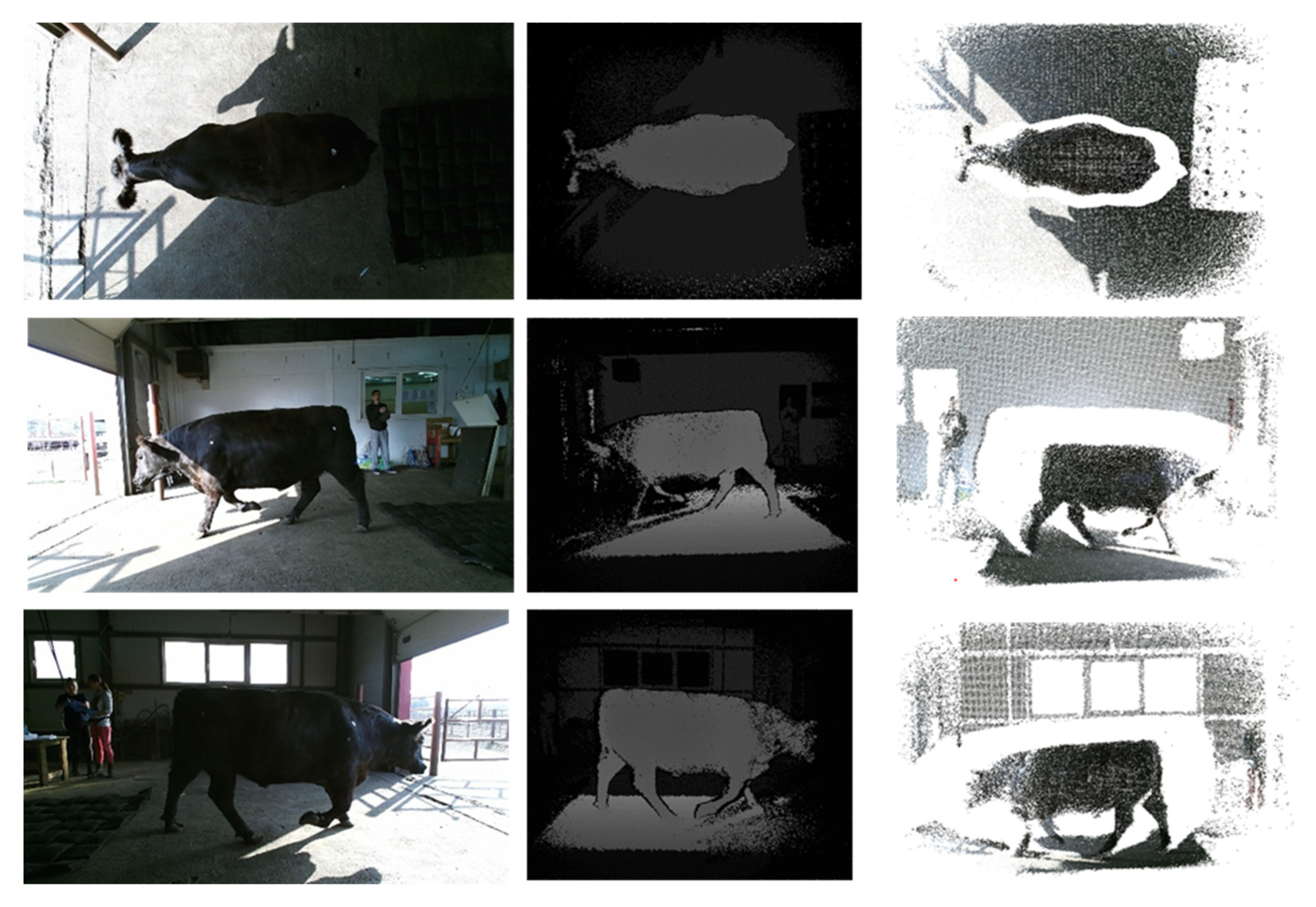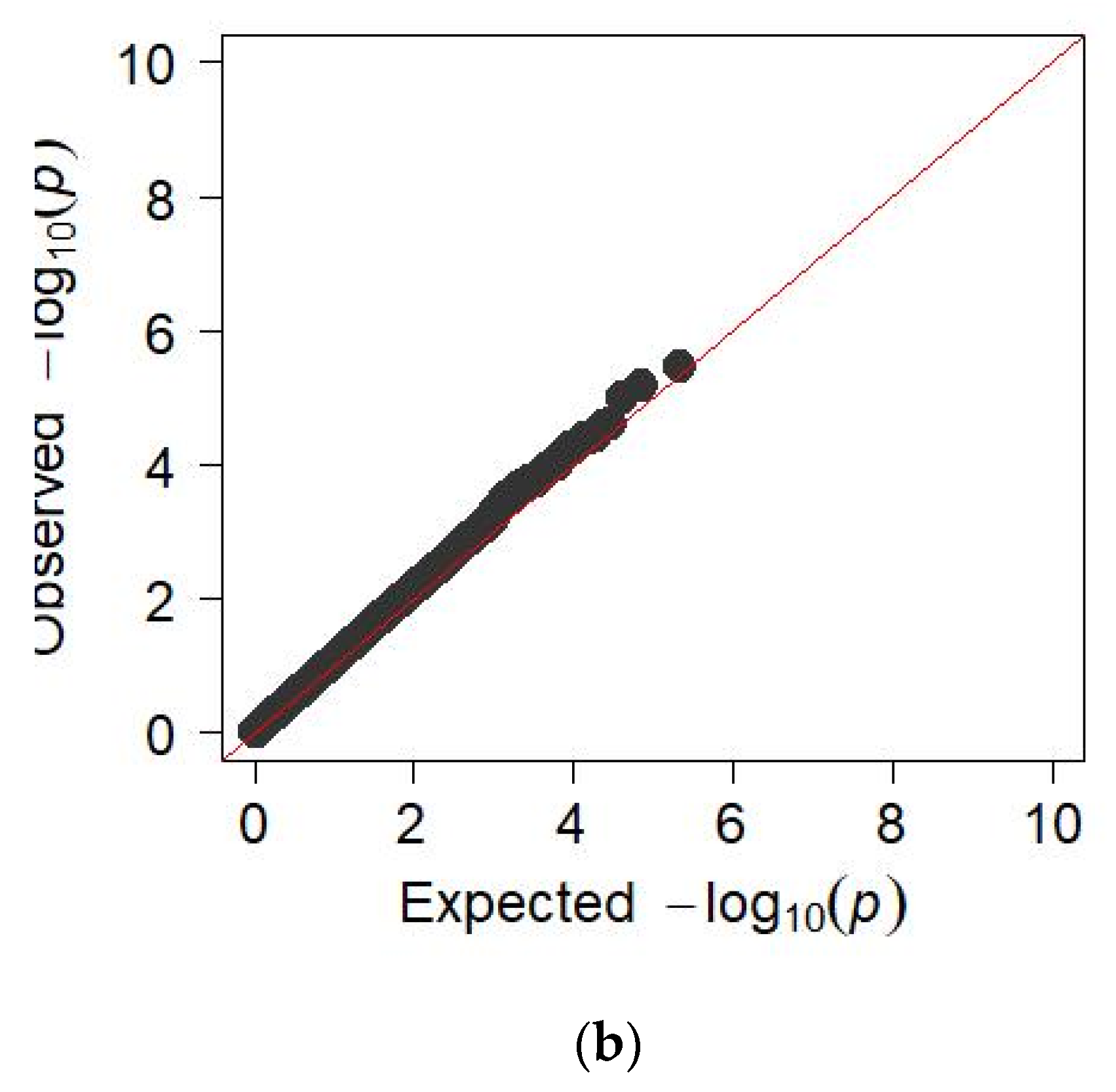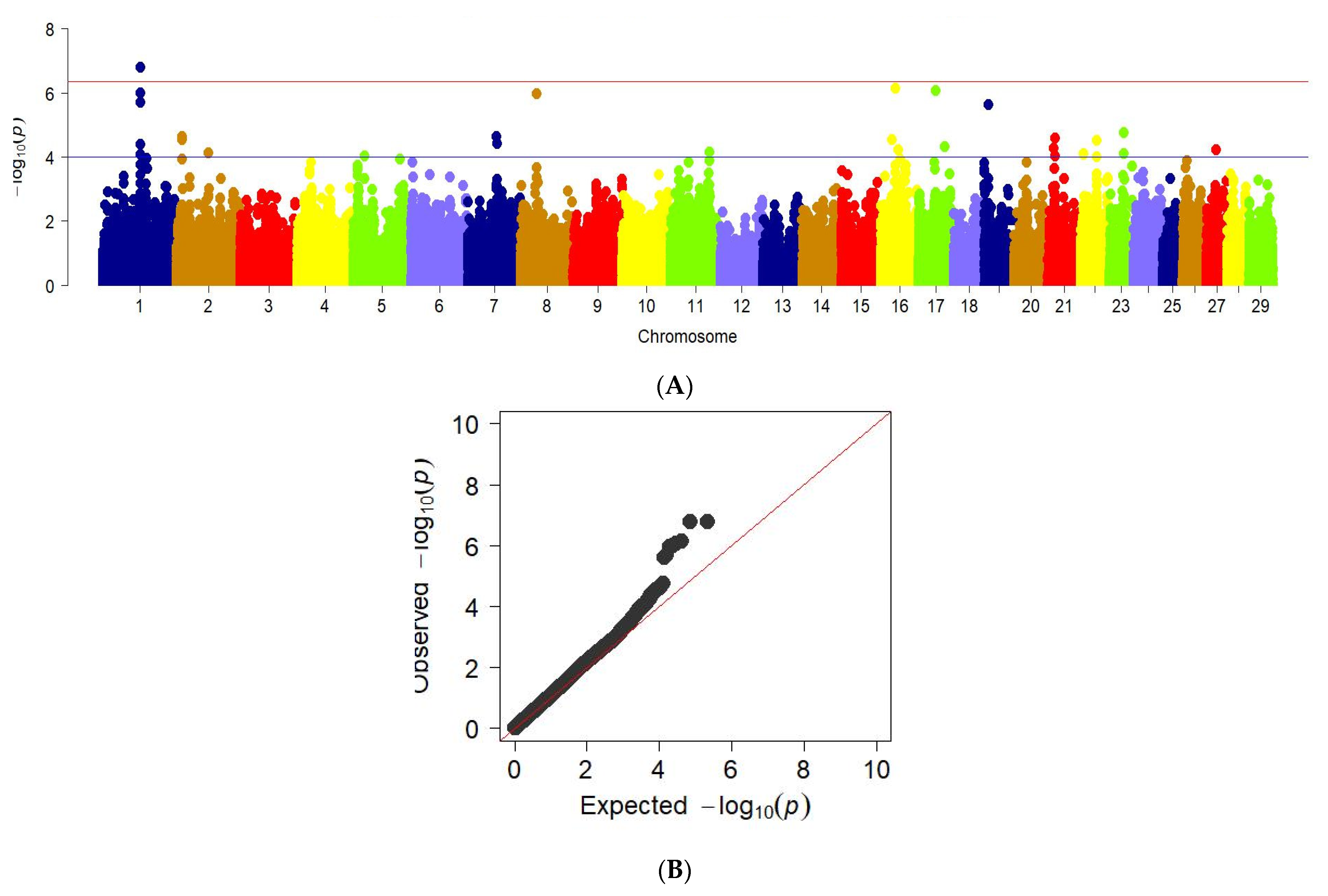Genome-Wide Associative Study of Phenotypic Parameters of the 3D Body Model of Aberdeen Angus Cattle with Multiple Depth Cameras
Abstract
:Simple Summary
Abstract
1. Introduction
- Computer vision can provide the lifetime evaluation of cattle by 3-D visualization of economic-biological and genetic features.
- A test analysis of genome-wide associations revealed the potential loci of quantitative traits on cattle chromosomes for chest width, chest girth, and meat output on bones.
- Database creation: the database contains raw RGB-D images, point clouds, and live weight, measurements obtained from a 3-D model (live weight, withers height, hip height, chest width, chest height), genotyping data, slaughter characteristics—live weight, meat yield, stress losses, characteristics of the front quarters (19 parameters), characteristics of the rear quarters (15 parameters), characteristics of offal (22 parameters) for 96 Aberdeen-Angus cattle.
2. Literature Review
3. Material and Methods
3.1. Animals and Ethics
3.2. Database
3.3. Genotyping
3.4. RGB-D Image Capture System
4. Results
4.1. RGB-D Image Capture System
- withers height is defined as the height of the highest point at the withers;
- hip height in the sacrum is the height of the highest point at the sacrum;
- chest width is defined as the width vertically tangent to the posterior corner of the shoulder blade;
- chest girth is defined as the vertical tangent to the back corner of the shoulder blade.
4.2. GWAS Analysis
5. Discussion
6. Conclusions
Author Contributions
Funding
Institutional Review Board Statement
Informed Consent Statement
Data Availability Statement
Acknowledgments
Conflicts of Interest
References
- Lu, J.; Guo, H.; Du, A.; Su, Y.; Ruchay, A.; Marinello, F.; Pezzuolo, A. 2-D/3-D fusion-based robust pose normalisation of 3-D livestock from multiple RGB-D cameras. Biosyst. Eng. 2021, in press. [CrossRef]
- Pezzuolo, A.; Chiumenti, A.; Sartori, L.; Da Borso, F. Automatic Feeding System: Evaluation of energy consumption and labour requirement in North-East Italy dairy farm. Proc. Eng. Rural. Dev. 2016, 15, 882–887. [Google Scholar]
- Hindorff, L.A.; Sethupathy, P.; Junkins, H.A.; Ramos, E.M.; Mehta, J.P.; Collins, F.S.; Manolio, T.A. Potential etiologic and functional implications of genome-wide associations of genome-wide association loci for human diseases and traits. Proc. Natl. Acad. Sci. USA 2008, 106, 9362–9367. [Google Scholar] [CrossRef] [PubMed]
- Visscher, P.M.; Brown, M.A.; McCarthy, M.I.; Yang, J. Five Years of GWAS Discovery. Am. J. Hum. Genet. 2012, 90, 7–24. [Google Scholar] [CrossRef]
- Pryce, J.; Bolormaa, S.; Chamberlain, A.; Bowman, P.; Savin, K.; Goddard, M.; Hayes, B. A validated genome-wide association study in 2 dairy cattle breeds for milk production and fertility traits using variable length haplotypes. J. Dairy Sci. 2010, 93, 3331–3345. [Google Scholar] [CrossRef]
- Liu, W.; Li, D.; Liu, J.; Chen, S.; Qu, L.; Zheng, J.; Xu, G.; Yang, N. A Genome-Wide SNP Scan Reveals Novel Loci for Egg Production and Quality Traits in White Leghorn and Brown-Egg Dwarf Layers. PLoS ONE 2011, 6, e28600. [Google Scholar] [CrossRef]
- Gregersen, V.R.; Conley, L.N.; Sørensen, K.K.; Guldbrandtsen, B.; Velander, I.H.; Bendixen, C. Genome-wide association scan and phased haplotype construction for quantitative trait loci affecting boar taint in three pig breeds. BMC Genomics 2012, 13, 22. [Google Scholar] [CrossRef]
- Bulik-Sullivan, B.K.; Loh, P.R.; Finucane, H.K.; Ripke, S.; Yang, J.; Schizophrenia Working Group of the Psychiatric Genomics Consortium; Patterson, N.; Daly, M.J.; Price, A.L.; Neale, B.M. LD Score regression distinguishes confounding from polygenicity in genome-wide association studies. Nat. Genet. 2015, 47, 291. [Google Scholar] [CrossRef]
- Hawlader, A.-M.; Priscila, B.; Dajeong, L.; Park, B.; Gondro, C. A guide to imputation of low-density single nucleotide polymorphism data up to sequence level. J. Anim. Breed. Genomics 2017, 1, 59–68. [Google Scholar] [CrossRef]
- Strucken, E.M.; Al-Mamun, H.A.; las Heras-Saldana, S.; Bedhane, M.N.; Lim, D.; Park, B. Finding the marble—The polygenic architecture of intramuscular fat. J. Anim. Breed. Genomics 2017, 1, 69–76. [Google Scholar] [CrossRef]
- Fortes, M.R.; DeAtley, K.L.; Lehnert, S.A.; Burns, B.M.; Reverter, A.; Hawken, R.J.; Boe-Hansen, G.; Moore, S.S.; Thomas, M.G. Genomic regions associated with fertility traits in male and female cattle: Advances from microsatellites to high-density chips and beyond. Anim. Reprod. Sci. 2013, 141, 1–19. [Google Scholar] [CrossRef] [PubMed]
- Sermyagin, A.A.; Bykova, O.A.; Loretts, O.G.; Kostyunina, O.V.; Zinovieva, N.A. Genomic variability assess for breeding traits in holsteinizated Russian Black-and-White cattle using GWAS analysis and ROH patterns. Sel’skokhozyaistvennaya Biol. 2020, 55, 257–274. [Google Scholar] [CrossRef]
- Guo, J.; Jorjani, H.; Carlborg, Ö. A genome-wide association study using international breeding-evaluation data identifies major loci affecting production traits and stature in the Brown Swiss cattle breed. BMC Genet. 2012, 13, 82. [Google Scholar] [CrossRef]
- Taye, M.; Kim, J.; Yoon, S.H.; Lee, W.; Hanotte, O.; Dessie, T.; Kemp, S.; Mwai, O.A.; Caetano-Anolles, K.; Cho, S.; et al. Whole genome scan reveals the genetic signature of African Ankole cattle breed and potential for higher quality beef. BMC Genet. 2017, 18, 11. [Google Scholar] [CrossRef] [PubMed]
- Dawood, M.; Kramer, L.M.; Shabbir, M.I.; Reecy, J.M. Genome-Wide Association Study for Fatty Acid Composition in American Angus Cattle. Animals 2021, 11, 2424. [Google Scholar] [CrossRef] [PubMed]
- Devani, K.; Plastow, G.; Orsel, K.; Valente, T.S. Genome-wide association study for mammary structure in Canadian Angus cows. PLoS ONE 2020, 15, e0237818. [Google Scholar] [CrossRef]
- Meirelles, S.L.; Gouveia, G.V.; Gasparin, G.; Alencar, M.M.; Gouveia, J.J.; Regitano, L.C. Candidate gene region for control of rib eye area in Canchim beef cattle. Genet. Mol. Res. 2011, 10, 1220–1226. [Google Scholar] [CrossRef] [PubMed]
- Mujibi, F.D.N.; Nkrumah, J.D.; Durunna, O.N.; Stothard, P.; Mah, J.; Wang, Z.; Basarab, J.A.; Plastow, G.; Crews, D.H.; Moore, S.S. Accuracy of genomic breeding values for residual feed intake in crossbred beef cattle1. J. Anim. Sci. 2011, 89, 3353–3361. [Google Scholar] [CrossRef]
- Moreno-Sánchez, N.; Rueda, J.; Carabaño, M.J.; Reverter, A.; McWilliam, S.; González, C.; Díaz, C. Skeletal muscle specific genes networks in cattle. Funct. Integr. Genomics 2010, 10, 609–618. [Google Scholar] [CrossRef]
- Gonçalves, T.M.; de Almeida Regitano, L.C.; Koltes, J.E.; Cesar, A.S.M.; da Silva Andrade, S.C.; Mourão, G.B.; Gasparin, G.; Moreira, G.C.M.; Fritz-Waters, E.; Reecy, J.M.; et al. Gene Co-expression Analysis Indicates Potential Pathways and Regulators of Beef Tenderness in Nellore Cattle. Front. Genet. 2018, 9, 441. [Google Scholar] [CrossRef]
- Weikard, R.; Hadlich, F.; Hammon, H.M.; Frieten, D.; Gerbert, C.; Koch, C.; Dusel, G.; Kuehn, C. Long noncoding RNAs are associated with metabolic and cellular processes in the jejunum mucosa of pre-weaning calves in response to different diets. Oncotarget 2018, 9, 21052–21069. [Google Scholar] [CrossRef] [PubMed]
- Thomasen, J.R.; Willam, A.; Egger-Danner, C.; Sørense, A.C. Reproductive technologies combine well with genomic selection in dairy breeding programs. J. Dairy Sci. 2016, 99, 1331–1340. [Google Scholar] [CrossRef] [PubMed]
- Li, Z.; Wu, Z.; Ren, G.; Zhao, Y.; Liu, D. Expression patterns of insulin-like growth factor system members and their correlations with growth and carcass traits in Landrace and Lantang pigs during postnatal development. Mol. Biol. Rep. 2013, 40, 3569–3576. [Google Scholar] [CrossRef] [PubMed]
- Greguła-Kania, M.; Kosior-Korzecka, U.; Patkowski, K.; Juszczuk-Kubiak, E.; Plewik, M.; Gruszeck, T. Acute-phase proteins, cortisol and haematological parameters in ewes during the periparturient period. Reprod. Domest. Anim. 2020, 55, 393–400. [Google Scholar] [CrossRef]
- Ibtisham, F.; Zhang, L.; Xiao, M.; An, L.; Ramzan, M.B.; Naweb, A.; Zhao, Y.; Li, G.; Xu, Y. Genomic selection and its application in animal breeding. Thai J. Vet. Med. 2017, 47, 301–310. [Google Scholar]
- Yudin, N.S.; Voevoda, M.I. Molecular genetic markers for economically important traits in dairy cattle. Genetics 2015, 51, 600–612. [Google Scholar] [CrossRef]
- Solovieff, N.; Cotsapas, C.; Lee, P.H.; Purcell, S.M.; Smolle, J.W. Pleiotropy in complex traits: Challenges and strategies. Nat. Rev. Genet. 2013, 14, 483–495. [Google Scholar] [CrossRef]
- de Oliveira, H.R.; Silva, F.F.; Brito, L.F.; Guarini, A.R.; Jamrozik, J.; Schenkel, F.S. Comparing deregression methods for genomic prediction of test-day traits in dairy cattle. J. Anim. Breed. Genet. 2018, 135, 97–106. [Google Scholar] [CrossRef]
- Aldai, N.; Lavín, P.; Kramer, J.K.G.; Jaroso, R.; Mantecón, A.R. Breed effect on quality veal production in mountain areas: Emphasis on meat fatty acid composition. Meat Sci. 2012, 92, 687–696. [Google Scholar] [CrossRef]
- Chung, H.; Shin, S.; Chung, E. Effects of genetic variants for the bovine calpain gene on meat tenderness. Mol. Biol. Rep. 2014, 41, 2963–2970. [Google Scholar] [CrossRef]
- de Haas, Y.; Pszczola, M.; Soyeurt, H.; Wall, E.; Lassen, J. Invited review: Phenotypes to genetically reduce greenhouse gas emissions in dairying. J. Dairy Sci. 2017, 100, 855–870. [Google Scholar] [CrossRef] [PubMed]
- Signer-Hasler, H.; Burren, A.; Neuditschko, M.; Frischknecht, M.; Garrick, D.; Stricker, C.; Gredler, B.; Bapst, B.; Flury, C. Population structure and genomic inbreeding in nine Swiss dairy cattle populations. Genet. Sel. Evol. 2017, 49, 83. [Google Scholar] [CrossRef] [PubMed]
- Ruchay, A.; Kober, V.; Dorofeev, K.; Kolpakov, V.; Miroshnikov, S. Accurate body measurement of live cattle using three depth cameras and non-rigid 3-D shape recovery. Comput. Electron. Agric. 2020, 179, 105821. [Google Scholar] [CrossRef]
- Du, A.; Guo, H.; Lu, J.; Su, Y.; Ma, Q.; Ruchay, A.; Marinello, F.; Pezzuolo, A. Automatic livestock body measurement based on keypoint detection with multiple depth cameras. Comput. Electron. Agric. 2022, 198, 107059. [Google Scholar] [CrossRef]
- Ruchay, A.; Kober, V.; Dorofeev, K.; Kolpakov, V.; Dzhulamanov, K.; Kalschikov, V.; Guo, H. Comparative analysis of machine learning algorithms for predicting live weight of Hereford cows. Comput. Electron. Agric. 2022, 195, 106837. [Google Scholar] [CrossRef]
- Ruchay, A. CowDatabase2. Available online: https://github.com/ruchaya/CowDatabase2 (accessed on 14 August 2022).
- Purcell, S.; Neale, B.; Todd-Brown, K.; Thomas, L.; Ferreira, M.A.R.; Bender, D.; Maller, J.; Sklar, P.; de Bakker, P.I.W.; Daly, M.J.; et al. PLINK: A toolset for whole-genome association and population-based linkage analysis. Am. J. Hum. Genet. 2007, 81, 559–575. [Google Scholar] [CrossRef]
- Reich, D.; Reich, D.; Price, A.; Patterson, N. Principal component analysis of genetic data. Nat. Genet. 2008, 40, 491. [Google Scholar] [CrossRef]
- R Core Team. R: A Language and Environment for Statistical Computing. R Foundation for Statistical Computing, Vienna. 2018. Available online: http://www.R-project.org/ (accessed on 14 August 2022).
- Zhao, K.; Tung, C.W.; Eizenga, G.C.; Wright, M.H.; Ali, M.L.; Price, A.H.; Nortan, G.J.; Islam, M.R.; Reynolds, A.; Mezey, J.; et al. Genome-wide association mapping reveals a rich genetic architecture of complex traits in Oryza sativa. Nature 2011, 2, 467. [Google Scholar] [CrossRef]
- Meuwissen, T.H. Accuracy of breeding values of ‘unrelated’ individuals predicted by dense SNP genotyping. Genet. Sel. Evol. 2009, 41, 35. [Google Scholar] [CrossRef]
- Hirschhorn, J.N.; Daly, M.J. Genome-wide association studies for common diseases and complex traits. Nat. Rev. Genet. 2005, 6, 95–109. [Google Scholar] [CrossRef]
- Frischknecht, M.; Pausch, H.; Bapst, B.; Signer-Hasler, H.; Flury, C.; Garrick, D.; Stricker, C.; Fries, R.; Gredler-Grandl, B. Accurate sequence imputation enables precise QTL mapping in Brown Swiss cattle. In Book of Abstracts of the 67th Annual Meeting of the European Federation of Animal Science, Proceedings of the 67th Annual Meeting of the European Federation of Animal Science, Belfast, UK, 29 August–2 September 2016; Academic Publishers: Wageningen, The Netherlands, 2016; Volume 104. [Google Scholar] [CrossRef]
- Van Raden, P.M. Efficient Methods to Compute Genomic Predictions. J. Dairy Sci. 2008, 91, 4414–4423. [Google Scholar] [CrossRef] [PubMed]
- Bolormaa, S.; Hayes, B.J.; Savin, K.; Hawken, R.; Barendse, W.; Arthur, P.F.; Herd, R.M.; Goddard, M.E. Genome-wide association studies for feedlot and growth traits in cattle1. J. Anim. Sci. 2011, 89, 1684–1697. [Google Scholar] [CrossRef] [PubMed]
- Purfield, D.; Evans, R.D.; Berry, D.P. Reaffirmation of known major genes and the identification of novel candidate genes associated with carcass-related metrics based on whole genome sequence within a large multi-breed cattle population. BMC Genomics 2019, 20, 720. [Google Scholar] [CrossRef] [PubMed]
- McClure, M.C.; Morsci, N.S.; Schnabel, R.D.; Kim, J.W.; Yao, P.; Rolf, M.M.; McKay, S.D.; Gregg, S.J.; Chapple, R.H.; Northcutt, S.L.; et al. A genome scan for quantitative trait loci influencing carcass, post-natal growth and reproductive traits in commercial Angus cattle. Anim. Genet. 2010, 41, 597–607. [Google Scholar] [CrossRef]
- Sherman, E.L.; Nkrumah, J.D.; Bartusiak, C.L.R.; Murdoch, B.; Moore, S.S. Fine mapping quantitative trait loci (QTL) for feed intake and efficiency in beef cattle. J. Anim. Sci. 2009, 87, 37–45. [Google Scholar] [CrossRef]
- Nkrumah, J.D.; Sherman, E.L.; Li, C.; Marques, E.; Crews, D.H.; Bartusiak, R., Jr.; Murdoch, B.; Wang, Z.; Basarab, J.A.; Moore, S.S. Primary genome scan to identify putative quantitative trait loci for feedlot growth rate, feed intake, and feed efficiency of beef cattle. J. Anim. Sci. 2007, 85, 3170–3181. [Google Scholar] [CrossRef]








| Indication | X | m | Cv, % | Min | Max |
|---|---|---|---|---|---|
| Live weight, kg | 614.9 | 3.4 | 5.4 | 556.0 | 746.0 |
| Withers height, cm | 143.1 | 0.6 | 3.9 | 119.0 | 153.0 |
| Hip height, cm | 146.4 | 0.6 | 3.9 | 122.0 | 156.0 |
| Chest width, cm | 52.2 | 0.2 | 3.5 | 48.0 | 56.0 |
| Chest girth, cm | 217.1 | 0.6 | 2.5 | 205.0 | 230.0 |
| Meat output on bones, % | 60.4 | 0.1 | 2.1 | 57.0 | 63.3 |
Publisher’s Note: MDPI stays neutral with regard to jurisdictional claims in published maps and institutional affiliations. |
© 2022 by the authors. Licensee MDPI, Basel, Switzerland. This article is an open access article distributed under the terms and conditions of the Creative Commons Attribution (CC BY) license (https://creativecommons.org/licenses/by/4.0/).
Share and Cite
Ruchay, A.; Kolpakov, V.; Kosyan, D.; Rusakova, E.; Dorofeev, K.; Guo, H.; Ferrari, G.; Pezzuolo, A. Genome-Wide Associative Study of Phenotypic Parameters of the 3D Body Model of Aberdeen Angus Cattle with Multiple Depth Cameras. Animals 2022, 12, 2128. https://doi.org/10.3390/ani12162128
Ruchay A, Kolpakov V, Kosyan D, Rusakova E, Dorofeev K, Guo H, Ferrari G, Pezzuolo A. Genome-Wide Associative Study of Phenotypic Parameters of the 3D Body Model of Aberdeen Angus Cattle with Multiple Depth Cameras. Animals. 2022; 12(16):2128. https://doi.org/10.3390/ani12162128
Chicago/Turabian StyleRuchay, Alexey, Vladimir Kolpakov, Dianna Kosyan, Elena Rusakova, Konstantin Dorofeev, Hao Guo, Giovanni Ferrari, and Andrea Pezzuolo. 2022. "Genome-Wide Associative Study of Phenotypic Parameters of the 3D Body Model of Aberdeen Angus Cattle with Multiple Depth Cameras" Animals 12, no. 16: 2128. https://doi.org/10.3390/ani12162128








